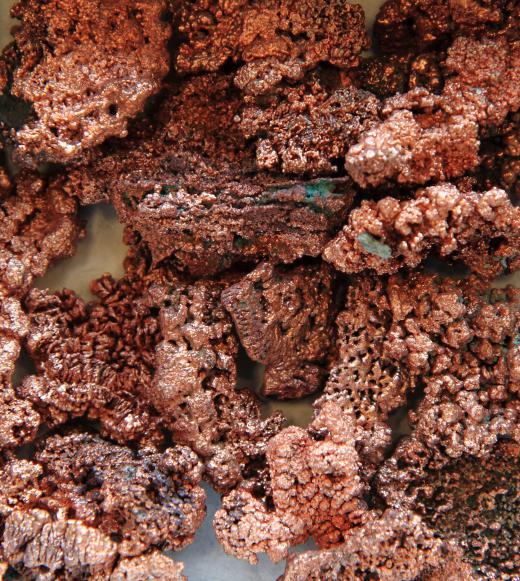At AboutMechanics, we're committed to delivering accurate, trustworthy information. Our expert-authored content is rigorously fact-checked and sourced from credible authorities. Discover how we uphold the highest standards in providing you with reliable knowledge.
What is Speiss?
A speiss is a byproduct of extracting pure copper, lead or another metal from its impure form. It is generally made up mostly of iron and arsenic with trace amounts of other minerals. The mixture of impure source metals used is called ore, and the science behind this extraction process is called metallurgy. The oldest form of metallurgy involves "smelting" ores for extraction. This technique has been practiced for thousands of years and is still common today.
To smelt metal, a worker combines raw metal ores with additives and heats them up to very high temperatures in a blast furnace. The temperature is very carefully controlled and is based on the melting point of the unwanted material in the furnace. When the mixture is hot enough, the additives bond with the impurities found naturally in the ore. Since these bonded chemicals all have different weights and boiling temperatures, they separate naturally in different layers inside the blast furnace. They can then be removed and the remaining material is a very pure metal.

When the metal and its impurities are in the form of this layered hot liquid it is called the molten phase. Speiss, generally made up of iron arsenide, rises near the top during the molten phase and can be removed along with other unwanted layers. The material in some of these layers will be used in another process to extract any remaining useful metals. Some layers will be discarded. Until the last century speiss was commonly discarded, since people did not think it had any useful industrial purposes.
That belief changed when speiss was discovered to be very useful in making semiconductors. Today, many household electronics such as computers, phones, and televisions use semiconductors. They are also an important component of solar cells because they can convert light energy to electrical energy.
The addition of speiss to the transistors of a semiconductor allows the semiconductor to be much more conductive. This process is called doping transistors. The increased conductivity greatly improves the usefulness of the semiconductors and allows them to be much smaller.
In 2008 it was discovered that iron arsenide speiss can be used to make more efficient superconductors as well. Superconductors deliver a consistent current with almost no energy loss, but they can usually only do this at very cold temperatures. When a superconductor uses iron arsenide it can work at temperatures that are closer to regular room temperature. The process still isn’t fully understood by scientists, and is currently being researched. Superconductors do not have any home applications yet, but are used in laboratory settings.
Since speiss is such a common and useful industrial byproduct it will continue to be found on circuit boards. It is also likely to power more electronics as well since solar panels are increasing in popularity. Given the performance improvements it has shown in research settings, speiss may be used in the first commercially-available superconductor.
AS FEATURED ON:
AS FEATURED ON:











Discuss this Article
Post your comments